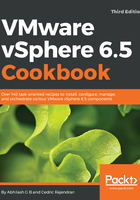
How it works...
When you upgrade from vSphere 5.5 to vSphere 6.5, you start with upgrading all the SSO instances. When the SSO instances are upgraded, the existing vSphere 5.5 environment will remain unaffected and will also be accessible via the already existing instance of the vSphere Web Client. If the existing SSO is not embedded, then the upgrade will result in a separate vSphere 6.5 PSC instance. The result remains the same regardless of the platform vCenter is deployed on. If you have more than one vCenter server connecting to the same SSO domain, then post the upgrade of one of the vCenter Servers, the newer vSphere Web Client 6.5 can be used to view/manage both vSphere 6.5 and 5.5 vCenter Servers. If you have more than one SSO/PSC servers, then upgrading one among them will not affect any of the services including vCenter Servers, except for the linked mode configuration, which will not be able to link two disparate vCenter versions.
Another important aspect to keep in mind is that the Platform Services Controller (PSC) and vCenter Server (Appliance or Windows) will manage two separate sets of services. The following table lists some of the services managed by both the components:
